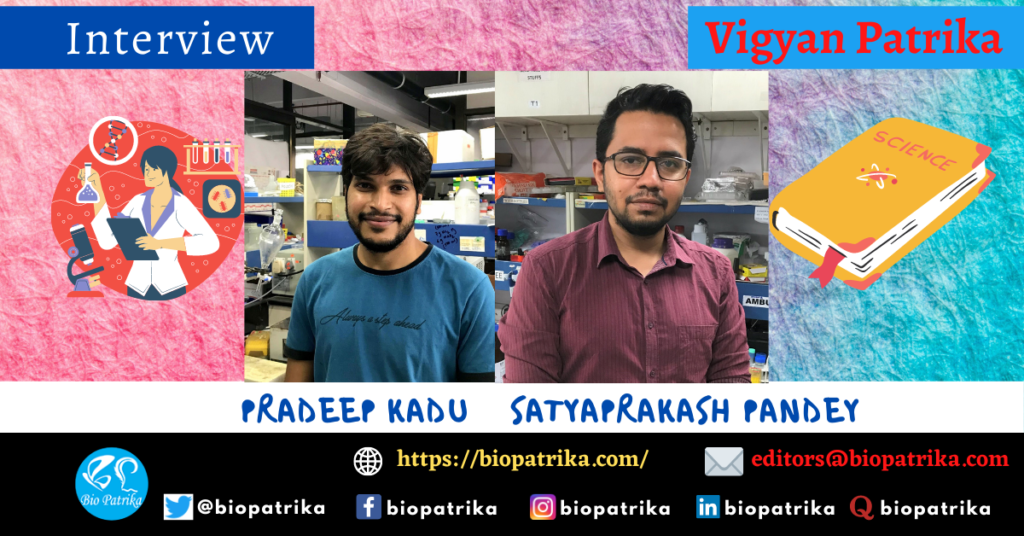Pradeep Kadu and Satyaprakash Pandey’s joint first author interview with Bio Patrika hosting “Vigyan Patrika”, a series of author interviews. Here, authors talk about their first author research article titled “Machine-Free Polymerase Chain Reaction with Triangular Gold and Silver Nanoparticles” published in J Phys Chem Lett (2020).
Pradeep Kadu has completed his Masters in Applied Chemistry from the Visvesvaraya National Institute of Technology (VNIT) Nagpur. In June 2016, he qualified the CSIR-JRF exam conducted by CSIR Delhi, and joined as a Research Scholar (Ph.D. student) in the Department of Biosciences and Bioengineering, IIT Bombay under the supervision of Prof. Samir Maji. His research work is mainly focused on shape-controlled synthesis of highly plasmonic metal nanoparticles and their interaction with biomolecular scaffolds using amyloids and their applications in bioassays. Besides work, he loves vector designing and art illustration for scientific articles.
Satyaprakash Pandey has completed his doctorate in Biological Sciences from CSIR- Institute of Genomics and Integrative Biology (IGIB) in 2016. He completed a two-year post-doctoral work in ERIBA, Netherlands. He is currently working with Prof. Samir Maji at Department of Biosciences and Bioengineering since August 2018. His research work majorly deals with understanding biomolecular interactions and utilize them in bioassays, both under in vitro and inside the cells. He likes to stay curious, read and write on science, debunk pseudo-science and engage in philosophical discussions.
How would you explain your paper’s key results to the non-scientific community?
The field of nano-plasmonic is attracting researchers for decades. In recent times, new strategies related to the plasmonic effects of metal nanoparticles are being explored with potential applications, such as photothermal hyperthermia, photo-induced catalytic reactions, and photonic isomerization of chemical structures.
We aimed to synthesize nanoparticles with robust and scalable photothermal properties. Using a systematic and cost-effective synthesis approach, we could synthesize triangular-shaped gold and silver nanoparticles using lemongrass extract. Our synthesis method is a greener approach and can be scaled to produce triangular and spherical nanoparticles. Interestingly, while evaluating these nanoparticles’ photothermal properties, we found that irradiating these particles with a laser could produce discrete temperatures depending on laser exposure and intensity. Thus, we had a “nanoheater” device that can be tuned to attain desired temperatures, and this provided us with a unique opportunity to explore the biological application of these nanoheaters.

Polymerase chain reaction (PCR) is the preferred diagnostic method for infections and is widely used in biomedical research. A variable temperature PCR to synthesize DNA products from a known template is still challenging due to reagent and equipment costs. We applied our “nanoheater” devices in a machine-free PCR setting, achieved the desired temperature, and produced DNA yields comparable to a conventional machine PCR. Comparing the photothermal properties of gold and silver nanoparticles, we, for the first time, showed that triangular silver nanoparticles are better nanoheaters (compared to gold counterparts). These inexpensive nanoheaters have immense applications and are currently being explored in our lab and the scientific community.
“…nanoparticles can be utilized as “point-of-care” diagnostic modules for PCR-based diagnostics in remote areas, especially in detecting infectious diseases.”
What are the possible consequences of these findings for your research area?
Our work has provided a method to synthesize predominant triangular nanoparticles that are nanoheater devices. These devices have immense photothermal therapy applications and could be utilized for other plasmonic applications, such as isomerization, photonic cancer therapy, and photon-induced degradation of organic molecules. Our study could potentially be helpful for further studies related to photo-plasmonic applications. Moreover, these nanoparticles can be utilized as “point-of-care” diagnostic modules for PCR-based diagnostics in remote areas, especially in detecting infectious diseases.
What was the exciting moment (eureka moment) during your research?
It is tough to pinpoint the exact Eureka moment. But there were two exciting moments during this research. One was visualizing these triangular-shaped nanoparticles under a very high-resolution transmission electron microscope. Another exciting moment was when these nanoparticles could attain temperatures greater than 90 °C. These two moments provided us with an opportunity to use these nanoparticles as tunable nanoheater devices with extensive applications in biology and chemistry.
What do you hope to do next?
A potential application in these pandemic times is to use these machine-free nanoparticles to diagnose and detect rare infectious diseases in remote areas. Parallelly, we are also making a bio-conjugated nanohybrid system, where nanoparticles will be associated with the bio-molecules such as proteins/peptides/DNA to explore its catalysis applications. In the long run, we are also interested in delivering these nanoparticles for photothermal therapy purposes.
Where do you seek scientific inspiration?
Nature teaches us more than any person. Our work is majorly inspired by a combined approach of engineering and biology. As scientists, we aim to understand and harness the knowledge from the secret quality of nature and then simulate them in lab settings for translational applications to help society.
How do you intend to help Indian science improve?
Indian science is becoming more and more multidisciplinary, where a combination of chemists, physicists, and biologists is attempting to address the problems with unique solutions. We are incredibly fortunate to be at the Indian Institute of Technology (IIT), where talented scientists and collaborative opportunities can ameliorate our work to the next level. We aim to engage in bilateral projects that can benefit Indian society and the scientific community in the future.
Reference
Kadu P, Pandey S, Neekhra S, Kumar R, Gadhe L, Srivastava R, Sastry M, Maji SK. Machine-Free Polymerase Chain Reaction with Triangular Gold and Silver Nanoparticles. J Phys Chem Lett. 2020 Dec 17;11(24):10489-10496. doi: 10.1021/acs.jpclett.0c02708
Email: meetpradeepngp@gmail.com; satya.22j@gmail.com
Edited by: Manveen K. Sethi (Volunteer, Biopatrika)
